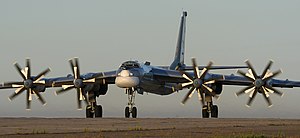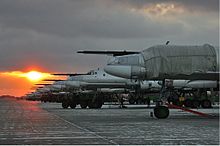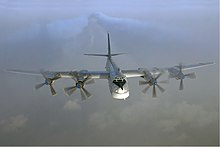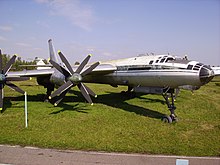From Wikipedia, the free encyclopedia
| Tu-95 | |
|---|---|
 |
|
| Tu-95MS at Engels Air Force Base | |
| Role | Strategic bomber, missile carrier, airborne surveillance |
| National origin | Soviet Union |
| Manufacturer | Tupolev |
| First flight | 12 November 1952 |
| Introduction | 1956 |
| Status | Active in service |
| Primary users | Soviet Air Forces Soviet Navy Russian Air Force |
| Produced | 1952–1994 |
| Number built | 500+ |
| Variants | Tupolev Tu-114 Tupolev Tu-119 Tupolev Tu-142 |
The aircraft has four Kuznetsov NK-12 engines, each driving contra-rotating propellers. It also remains the only turboprop-powered strategic bomber in operational use. Its distinctively swept-back wings are at 35°, a very sharp angle by the standards of propeller-driven aircraft, and justified by its operating speeds and altitudes. Its blades, whose tips move faster than the speed of sound, make it one of the noisiest military aircraft on earth.[2]
Contents
Design and development
A new requirement was issued to both Tupolev and Myasishchev design bureaus in 1950: the proposed bomber had to have an un-refueled range of 8000 km (4,970 mi) — far enough to threaten key targets in the United States. Other goals included the ability to carry an 11,000 kg (11 ton) load over the target.[citation needed]
The big problem for Tupolev was the engine choice: the Tu-4 showed that piston engines were not powerful enough to fulfill that role, while the fuel-hungry AM-3 jet engines of the proposed T-4 intercontinental jet bomber did not provide adequate range.[4] Turboprops offered more power than piston engines and better range than jets, with a top speed in between.
Tupolev's proposal was selected and Tu-95 development was officially approved by the government on 11 July 1951. It featured four Kuznetsov[5] coupled turboprops fitted with eight-bladed contra-rotating propellers, producing a nominal 8,948 kW (12,000 eshp) power rating. Unlike the advanced engine design, the fuselage was conventional: a mid-wing cantilever monoplane with 35 degrees of sweep, an angle which ensured the main wing spar passed through the fuselage in front of the bomb bay. Retractable tricycle landing gear was fitted, with all three gear strut units retracting rearwards, with the main gear units retracting rearwards into extensions of the inner engine nacelles.[citation needed]
The Tu-95/I, with 2TV-2F engines, first flew 11 November 1952 with test pilot Alexey Perelet at the controls.[6] After six months of test flights this aircraft suffered a propeller gearbox failure and crashed, killing Perelet. The second aircraft, Tu-95/II featured four of the 12,000 ehp Kuznetsov NK-12 turboprops which proved more reliable than the coupled 2TV-2F. After a successful flight testing phase, series production of the Tu-95 started in January 1956.[5]

A Tu-95MS simulating aerial refueling with an Ilyushin Il-78 during the Victory Day Parade in Moscow on 9 May 2008.
Initially the United States Department of Defense evaluated the Tu-95 as having a maximum speed of 644 km/h (400 mph) with a range of 12,500 km (7,800 mi).[7] These numbers had to be revised upward numerous times.[citation needed]
Like its American counterpart, the Boeing B-52 Stratofortress, the Tu-95 has continued to operate in the Russian Air Force while several subsequent iterations of bomber design have come and gone. Part of the reason for this longevity was its suitability, like the B-52, for modification to different missions. Whereas the Tu-95 was originally intended to drop free-falling nuclear weapons, it was subsequently modified to perform a wide range of roles, such as the deployment of cruise missiles, maritime patrol (Tu-142), and even civilian airliner (Tu-114). An AWACS platform (Tu-126) was developed from the Tu-114. An icon of the Cold War, the Tu-95 has served not only as a weapons platform but as a symbol of Soviet and later Russian national prestige.
Tu-116
Operational history
Cold War icon
The Tu-95RT variant in particular was a veritable icon of the Cold War as it performed a vital maritime surveillance and targeting mission for other aircraft, surface ships and submarines. It was identifiable by a large bulge under the fuselage, which housed a radar antenna that was used to search for and target surface ships.[citation needed]The Tu-95 carried and dropped the AN602 Tsar Bomba, the largest and most powerful nuclear weapon ever detonated (deliberately de-rated from 100 to 50 megatons), in 1961.[8]
Present and future status
In 1992, newly independent Kazakhstan began returning the Tu-95 aircraft of the 79th Heavy Bomber Aviation Division at Dolon air base to the Russian Federation.[9] The bombers joined those already at the Far Eastern Ukrainka air base.[10]All Tu-95s now in Russian service are the Tu-95MS variant, built in the 1980s and 1990s. On August 18, 2007, then-President Vladimir Putin announced that Tu-95 patrols would resume, 15 years after they had ended.[11]
NATO fighters are often sent to intercept Tu-95s as they perform their missions along the periphery of NATO airspace, often in close proximity to each other.[12][13][14][15][16][17][18][19]
Russian Tu-95s reportedly took part in a naval exercise off the coasts of France and Spain in January 2008, alongside Tu-22M3 Backfire strategic bombers and airborne early-warning aircraft.[20]
During the Russian Stability 2008 military exercise in October 2008, Tu-95MS aircraft fired live air-launched cruise missiles for the first time since 1984. The long range of the Raduga Kh-55 cruise missile means Tu-95MS Bears can once again serve as a strategic weapons system.[21]
On 8 July 2011, two Russian Tu-95 turboprop bombers flew an 11-hour flight over the northeast Pacific Ocean and the Sea of Japan. Japan sent two fighter pairs of F-15 and F-2 aircraft to intercept and escort the Russian bombers over portions of the flight. On 8 September 2011, two Russian Tu-95 bombers flew near Japanese airspace, and Japan Air Self Defense Force fighters were sent to intercept them.[22]
During 2012, according to U.S. military sources, two different incidents took place involving Russian Tu-95 Bear-H bombers flying near United States airspace. The first occurred in mid-June during Russian military exercises near Alaska, prompting NORAD to send U.S. F-15s and Canadian CF-18 fighters to intercept and escort the two Russian bombers from the area. The second occurred on July 4 when two Tu-95's were intercepted by U.S. aircraft off the west coast of the United States, and U.S. fighters again escorted the Russian bombers from the area.[23]
In February 2013, two Russian Tu-95 Bear-H bombers were intercepted by US jets while circling the western Pacific island of Guam.[24] The incident is considered highly unusual because Russian strategic bombers have not been known to conduct operations in the vicinity of Guam from bases in the Russian Far East.[25]
In April 2013, two Russian Tu-95 Bear-H bombers were detected flying into the Alaska Air Defense Identification Zone ADIZ. Two US Lockheed Martin F-22 Raptors intercepted and visually identified the bombers on April 28.[26]
In July 2013, two Russian Tu-95 Bear-H bombers were detected flying north near the Korean peninsula and Japan's northern Hokkaido Island. Three Japanese jets and a South-Korean jet intercepted and escorted the Russian bombers.[27]
On April 23, 2014 Royal Air Force fighters intercepted 2 Tu-95s in international airspace off the coast of Scotland.[28]
In the near future, the strategic bombers Tu-160, Tu-95 and Tu-22M3 will receive their orders and instructions according to the principle of telegraph or SMS.[29]
Variants and derivatives
A Tu-95 performs a fly-over with an Il-78 and two MiG 29s simulating aerial refueling at the Victory Day Parade in Moscow on 9 May 2008.
- Tu-95/1: The first prototype powered by Kuznetsov 2TV-2F coupled turboprop engines.
- Tu-95/2: The second prototype powered by Kuznetsov NK-12 turboprops.
- Tu-95/Tu-95M: Basic variant of the long-range strategic bomber and the only model of the aircraft never fitted with a nose refuelling probe. Known to NATO as the Bear-A.
- Tu-95K: Experimental version for air-dropping a MiG-19 SM-20 jet aircraft.
- Tu-95K22: Conversions of the older Bear bombers, reconfigured to carry the Raduga Kh-22 missile and incorporating modern avionics. Known to NATO as the Bear-G.
- Tu-95K/Tu-95KD: Designed to carry the Raduga Kh-20 air-to-surface missile. The Tu-95KD aircraft were the first to be outfitted with nose probes. Known to NATO as the Bear-B.
- Tu-95KM: Modified and upgraded versions of the Tu-95K, most notable for their enhanced reconnaissance systems. These were in turn converted into the Bear-G configuration. Known to NATO as the Bear-C.
- Tu-95M-55: Missile carrier.
- Tu-95MR: Bear-A modified for photo-reconnaissance and produced for Naval Aviation. Known to NATO as the Bear-E.
- Tu-95MS/Tu-95MS6/Tu-95MS16: Completely new cruise missile carrier platform based on the Tu-142 airframe. This variant became the launch platform of the Raduga Kh-55 cruise missile. Known to NATO as the Bear-H and was referred to by the U.S. military as a Tu-142 for some time in the 1980s before its true designation became known.
- Tu-95N: Experimental version for air-dropping an RS ramjet powered aircraft.
- Tu-95RTs: Razvedchik Tseleukazatel: Variant of the basic Bear-A configuration, redesigned for maritime reconnaissance and targeting as well as electronic intelligence for service in the Soviet Naval Aviation. Known to NATO as the Bear-D.
- Tu-95U Uchebnyy: Trainer: Training variant, modified from surviving Bear-As but now all have been retired. Known to NATO as the Bear-T.
- Tu-95V: Special carrier aircraft to test-drop the largest thermonuclear weapon ever designed, the Tsar Bomba.
- Tu-96: long-range intercontinental high-altitude strategic bomber prototype, a high-altitude version of the Tupolev Tu-95 aircraft with high-altitude augmented turboprop TV-16 engines and with a new, enlarged area wing. Plant tests of the aircraft were performed with non-high altitude TV-12 engines in 1955–1956.[30]
- Tu-114: Airliner derivative of Tu-95.
- Tu-116: Tu-95 fitted with passenger cabins as a stop-gap while the Tu-114 was being developed. Only two converted.[31]
- Tu-95LAL: Experimental nuclear-powered aircraft project.
- Tu-126: AEW&C derivative of Tu-114, itself derived from the Tu-95.
- Tu-142: Maritime reconnaissance/anti-submarine warfare derivative of Tu-95. Known to NATO as the Bear-F.
Operators

A lineup at sunset of Tu-95MS at Engels Air Force Base in December 2005.
Current
- Russian Air Force: 63 Tu-95MS strategic bombers. As of 2012, 55 of them are combat-ready.[32]
Former
- 1 Tu-95MS in museum.[33]
- Ukrainian Air Force: Retired from military service.
- Soviet Air Forces, Long Range Aviation: Passed on to Russia and Ukraine.
- The first Tu-95 division, 106th TBAD (Heavy Bomber Air Division), was formed in 1956. The division commander was twice-Hero of the Soviet Union A. G. Molodchi.[34] The 106th TBAD incorporated the 409th TBAP (Heavy Bomber Air Regiment) (commander – Colonel M. M. Kharitonov) which was raised late in 1956 and the 1006th TBAP (commander – Colonel V. P. Pavlov) raised in 1956. The 106th TBAD's base was Uzin near Kiev.[citation needed]
- The 1223rd TBAP in Semipalatinsk, under the command of Hero of the Soviet Union Colonel V. M. Bezbokov, was raised in 1957, within the 79th Air Division (commander – twice-Hero of the Soviet Union General Major M. P. Taran). The 1223rd's targets were Canada and the north of the US.[citation needed]
- Soviet Naval Aviation
Specifications (Tu-95MS)
Data from Combat Aircraft since 1945[35]
General characteristics- Crew: 6–7; pilot, co pilot, flight engineer, communications system operator, navigator, tail gunner plus sometimes another navigator.[36]
- Length: 46.2 m[37] (151 ft 6 in[37])
- Wingspan: 50.10 m[37] (164 ft 5 in[37])
- Height: 12.12 m (39 ft 9 in)
- Wing area: 310 m² (3,330 ft²)
- Empty weight: 90,000 kg (198,000 lb)
- Loaded weight: 171,000 kg (376,200 lb)
- Max. takeoff weight: 188,000 kg (414,500 lb)
- Powerplant: 4 × Kuznetsov NK-12M turboprops, 11,000 kW (14,800 shp)[38] each
- Maximum speed: 920 km/h (510 knots, 575 mph)
- Range: 15,000 km (8,100 nmi, 9,400 mi)unrefueled
- Service ceiling: 13,716 m (45,000 ft)
- Rate of climb: 10 m/s (2,000 ft/min)
- Wing loading: 606 kg/m² (124 lb/ft²)
- Power/mass: 235 W/kg (0.143 hp/lb)
- Radar-controlled Guns: 1 or 2 × 23 mm AM-23 autocannon in tail turret.
- Missiles: Up to 15,000 kg (33,000 lb), including the Raduga Kh-20, Kh-22, Kh-26, and Kh-55/101/102 Air-to-surface missiles.
See also
- Related development
- Aircraft of comparable role, configuration and era
- Related lists








No comments:
Post a Comment